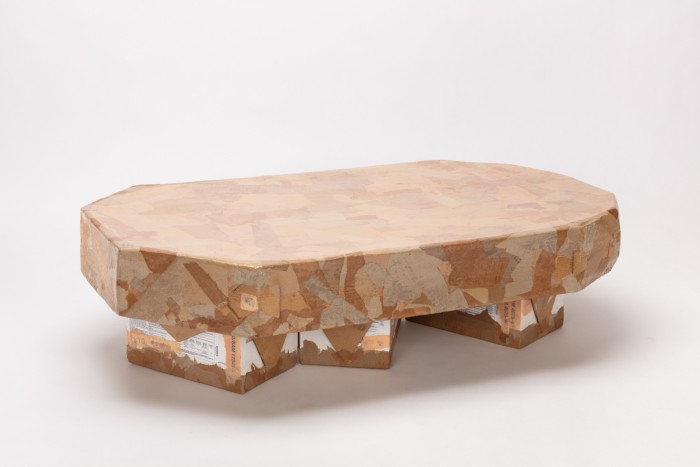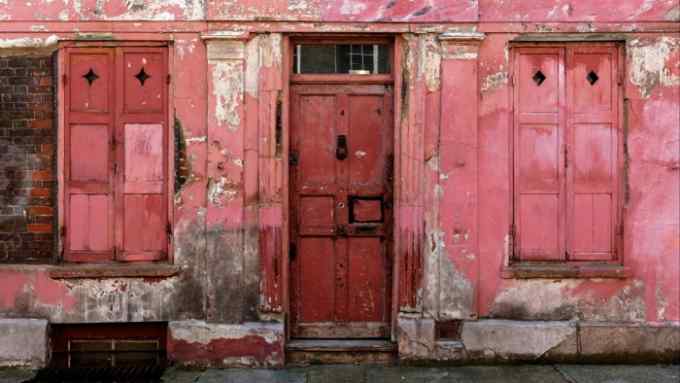Designer Max Lamb: ‘Touch, touch, touch’

Roula Khalaf, Editor of the FT, selects her favourite stories in this weekly newsletter.
In the world of limited-edition design, Max Lamb is perhaps the best-known furniture-maker of his generation. Now 42, he has built an international reputation thanks to a continuous stream of poetic but process-driven work. From irregularly shaped chairs hewn from blocks of polystyrene via consoles, chairs and daybeds constructed entirely from dowel rods to split-wood furniture finished in luscious lacquer by Japanese craftsmen, his pieces exude an easy-to-read honesty.
“I want my work to be legible and literal, and not superficial,” says Lamb, “and if somebody wants to buy it, I’m honoured. If somebody likes it, I’m happy.” A new furniture series of 34 unique pieces, launching on October 5 at London gallery Fumi, is made entirely of cardboard that has been pulped and layered and endlessly worked into a series of tables and chairs.

“I’ve used cardboard for years to make models and prototypes,” he says, “but now it’s become a primary material. We’ve been collecting it in the studio. It’s come to us as packaging, at no cost.” Using a wheat and water glue that he makes himself, the process of building up a form has been a quiet and safe one — just Lamb and three assistants in his studio. Unlike so much furniture-making, there is no waste, no toxic component, no noise.
“But it’s been frustrating,” he says. “I like speed, and this is the slowest process I’ve ever developed. There are things about paper that aren’t conducive to permanent furniture. We’ve had to build it up and up to make it stable.” He points to a two-metre-long dining table that is still waiting to be sealed with linseed oil. “That’s taken 17 days so far, not counting any of my time. It’s been a huge team effort. The expense here is all in human labour.” Its top is a beautiful patchwork of varying shades of brown and gold — the colours of the cardboard itself; its legs seem dappled in a muddy camouflage. Nearby is an exuberant round seat, formed on a blown-up balloon, its curvy surface overlaid with paper ribbons the colour of dried leaves.
Unlike some of his peers in the shiny world of limited-edition design, Lamb’s work is devoid of anxiety or tension or neediness; there are no running gags or steaming intellectualism, no tricks, no style. It is what it is: intuitive, material-led, at times primordial. Those polystyrene pieces could approximate to something carved by early man from a rock. “You become a designer by engaging with the physical world,” he says. “By touching things. Touch, touch, touch.” His degree show presentation at the Royal College of Art in 2006 included a stool made on the beach near where he grew up in St Austell, Cornwall, creating a mould in the sand and filling it with liquid metal. By the time the show finished, he was a star.


His studio is one of a collection of buildings clustered around a courtyard in picturesque Harrow-on-the-Hill, where London begins to give way to the countryside. First we look around the red-brick Mission Hall, built in a Dutch style in 1884-85 by Edward Prior, that Lamb has converted (with help from architect Michael Gollings) into a home for himself, his wife, the designer Gemma Holt, and their six-year-old son.
He did much of the work, making the deep-pink terrazzo flooring from crushed-up Dreadnought tiles reclaimed from the roof; creating his own flesh-coloured wall paint by adding brick dust to a standard base. Opposite is the studio: two pointy volumes by the architects Matheson Whiteley clad in shimmering corrugated aluminium. Another building on the Lamb campus is a house dating from 1400. He has yet to embark on its complicated restoration.
Two of Lamb’s three assistants, recent graduates, are busy at work — one fielding deliveries, another hand-knotting a multicoloured carpet for a huge cushion cover. A rack contains some remaining cardboard, though Lamb, a hoarder, says he has six or so garages dotted around London full of the stuff. What he has used already serves as a narrative of his life so far. The seat of one new cardboard chair is an old Fujitsu box, its logo still visible — “that’s from when I was still living with my parents,” he says. Another once contained fertiliser, according to its logo, and would have come from his grandfather’s farm.

The ideas of sustainability and reuse are built in to the Cardboard project, though it is a running concern in his work. In making the polystyrene pieces, he has managed a 2-3 per cent material waste rate; for a 2015 project, he used every possible part of a grand old ash tree that had grown on his grandfather’s farm, milling the last thin branches into ever smaller stools.
The result of his new work, in spite of the precaution of his endless papier-mâché layers, is perhaps less durable than the norm. “It is going to challenge people’s perceptions of furniture and how it should be treated,” says Lamb. “You’re more likely to hurt the chair than yourself, if you run into it. But perhaps we should learn to look after things better. And also to learn that things don’t have to be perfect forever.”
October 5-November 18, galleryfumi.com

Comments